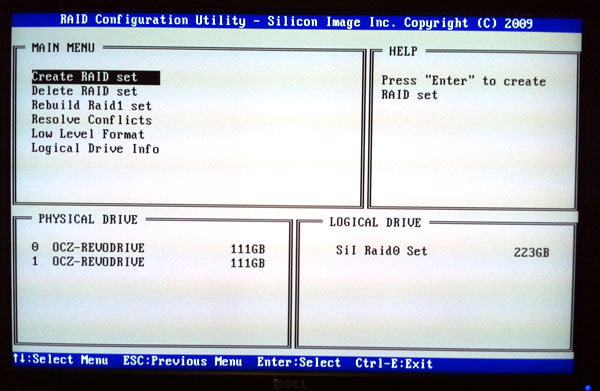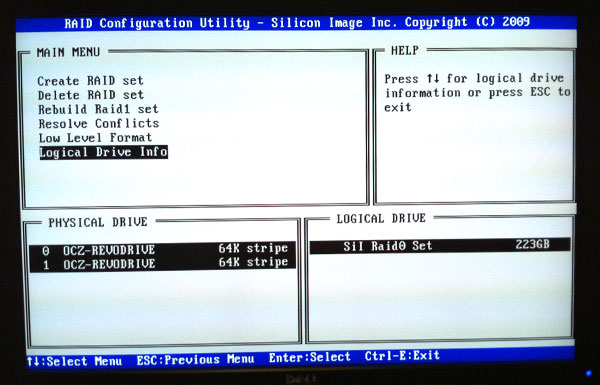OCZ's RevoDrive Preview: An Affordable PCIe SSD
by Anand Lal Shimpi on June 25, 2010 2:15 AM ESTInstallation and Early Issues
OCZ doesn’t do anything to hide what’s going on under the hood. The Silicon Image RAID BIOS loads at POST, it’ll even let you enter the BIOS and destroy the RAID array if you’d like. The first time I tried to install Windows on the RevoDrive I actually had to recreate the RAID array. I headed into the Silicon Image BIOS, asked to recreate the array, specified the entire 223GB capacity and hit ok. My sample is a bit early so I don’t expect that all users will have to deal with that, but just be aware that there are no abstraction layers here. You’re working with a pre-configured RAID array.


The RevoDrive is bootable, but you need to supply Windows with the appropriate drivers to recognize the controller. OCZ provided me with a set of 64-bit drivers for the Sil3124 controller and I was on my way. Windows 7 x64 installed without a hitch.
I did notice that I got consistency warnings between reboots however. The OS would run a chkdsk operation, find some issues with files, repair them and let me get on with things. Again, I’m not sure how much of this is due to the early nature of my sample.
The Test
| CPU | Intel Core i7 965 running at 3.2GHz (Turbo & EIST Disabled) |
| Motherboard: | Intel DX58SO (Intel X58) |
| Chipset: | Intel X58 + Marvell SATA 6Gbps PCIe |
| Chipset Drivers: | Intel 9.1.1.1015 + Intel IMSM 8.9 |
| Memory: | Qimonda DDR3-1333 4 x 1GB (7-7-7-20) |
| Video Card: | eVGA GeForce GTX 285 |
| Video Drivers: | NVIDIA ForceWare 190.38 64-bit |
| Desktop Resolution: | 1920 x 1200 |
| OS: | Windows 7 x64 |










62 Comments
View All Comments
shin0bi272 - Friday, June 25, 2010 - link
Please tell me you're going to give this away in your 13 year anniversary loot. I really want an SSD but Im unemployed and this one would last me a LONG time since its expandable (such a great idea btw).fwibbler - Friday, June 25, 2010 - link
Since a lot of people may be upgrading from older SSDs (like Vertex 1) it might be an idea to show one of them in a performance chart when you review the release version (in particular 2x Vertex 30GB ;-)buyaofeichu - Friday, June 25, 2010 - link
(nike-alliance).(com),Inc. We are the best online dealer,about all kinds of nike.run retailing and wholesale trade wordwidely for years. Free Shipping And Customs,Super Sale Off Retailing,With 1Week Delivery to your door.Breit - Friday, June 25, 2010 - link
wrong place pal... ;)SL_Eric - Friday, June 25, 2010 - link
Does using it on an NF200-equipped board (and the appropriate through-the-NF200 PCIe lanes) have any impact on performance?bji - Friday, June 25, 2010 - link
All this talk about upgradable flash using NAND chips on SODIMM cards inspired me to think about what the future of storage will look like.Is it likely that eventually, the SSD controllers will follow the same path that memory controllers have? Starting with external devices (which I would bet is the way that core memory was done back in the mainframe days) as we have now with external SSD controllers, then moving to controllers built into the motherboard, and finally moving to on-die controllers. All the while, with NAND flash becoming a raw commodity part that you just plug into SODIMM slots or similar on your motherboard?
So you'd buy RAM and put it in your RAM SODIMM slots, and then buy some NAND flash SODIMMS and plug those into your NAND SODIMM slots, each being handled by an on-board on on-die controller.
Is this the eventuality of solid state storage? It actually sounds really good to me. I suspect that breaking the devices apart like this, and making the SSD controllers a separate part of the system from the raw NAND flash, would allow for greater efficiency for both, and drive prices down and capacities up.
One drawback would be that the NAND flash sticks would have persisted data on them so to switch to new ones, you'd have to have somewhere to copy that data and then copy the data back onto the new sticks after you'd upgraded. Of course, that's really no different than what you have to do now when you buy a new SSD drive or (heaven forbid) spinning platter drive. The major difference being with external connector standards like SATA, you can add extra drives easily, whereas with SODIMM slots on the motherboard, you are more limited in the number of 'devices' that you can support at one time, making adding a temporary drive for the purposes of copying data around a bit harder.
allingm - Friday, June 25, 2010 - link
You know I was thinking exactly the same thing. It would be so much better if hard drive space was upgraded just like RAM. I think the RAM standard group should come up with a persistent memory storage standard.Shadowmaster625 - Monday, June 28, 2010 - link
You would just clone the SSD DIMM(s) drive image onto an external usb hard drive. Then restore the image onto the new flash DIMM(s) and, if necessary, resize the partition.nurd - Friday, June 25, 2010 - link
It seems to me that since, from the OS's standpoint, it's just a SiI 3124, if you broke the RAID and just treated it as two drives at the OS level (maybe striping them at THAT layer), you could TRIM just fine (assuming your 3124 driver supports it of course).ggathagan - Friday, June 25, 2010 - link
My guess is that you will never find TRIM support for SiL3124's.As Anand mentioned, one of the keys to the device's low cost is the use of relatively old silicon.
It would surprise me if Silicon Image was still actively doing any work on the 3124 drivers.
The latest Windows RAID drivers listed on their website are dated 2006, with a note for the 64-bit version that it supports Vista beta 2.
That part aside, TRIM support would depend on what it is about RAID that TRIM doesn't like.
Even if the controllers allows you to break up the pair to be seen as individual drives, the controller still considers each of them to be RAID0 devices.
I've no idea as to the issue between RAID and TRIM, but if the very fact that it's a RAID device disallows TRIM, then you're out of luck.
If the issue with TRIM and RAID has to do with data striping, then you might be correct, assuming that SI ever developed TRIM support for the 3124.